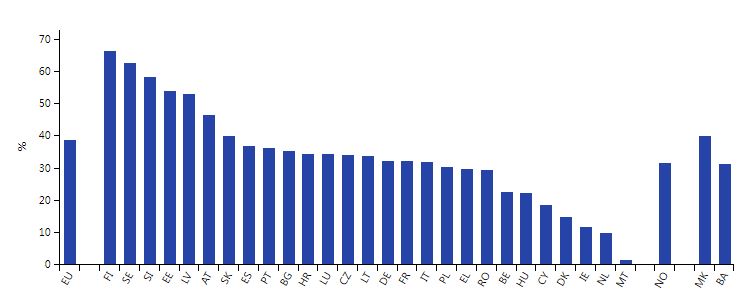The continuing importance of forestry to the Latvian economy is
revealed in recent Eurostat data.
Latvia is the fifth-most-heavily forested EU country, according
to the data, which comes from 2022, with 53% of the country
covered by trees. Forests cover more than half of the national
territory in 5 countries: Finland (66%), Sweden (63%), Slovenia
(58%), Estonia (54%) and Latvia (53%).
Forest area in the EU, 2022 (share of forest in total area, %)

Estimates for 2022: Belgium, Czechia, Denmark, Estonia,
Finland, Greece. Hungary, Italy, Latvia, Lithuania, Malta,
Netherlands, Spain, Sweden.
Total gross value added (GVA) generated by the forestry and
logging industry in the EU reached €27.9 billion in 2022,
marking a 13% increase from the previous year.
The GVA of the forestry and logging industry represented 0.17%
of the EU GDP in 2022, which is 19% less than the share in 2000
(0.21%). The GVA generated by forestry and logging accounted for
more than 1% of GDP in 4 countries in 2000: Sweden, Estonia,
Latvia and Finland. By 2022, this is still the case for 2
countries: Latvia and Finland.
On average, forests of EU countries generated 174 €/ha of GVA in
2022. The largest GVA per forest area is estimated for the
Netherlands (597 €/ha), Czechia (471 €/ha) and Slovakia (401
€/ha) in 2022. This indicator needs to be interpreted with care
when using it as a proxy to compare economic productivity of
forestry and logging across the EU, as it may be affected by the
types of activities performed by the forestry and logging
sector.

Table 1: Economic indicators for forestry and logging, 2000 and
2022
Source: Eurostat
In the EU, about 476 260 persons work in the forestry and
logging sector in 2022, which represents a decrease of 16%
compared to 2000. The largest workforce is recorded in Sweden
with 61 000 persons, followed by Romania (53 900 persons) and
Germany (42 000 persons). In Latvia, 13 200 persons are
classified as working in the sector.
The ratio of labour input per area of forest gives an indication
of the labour intensity of the sector across EU countries. In
2022, its mean value for the EU was 3 employed persons per 1 000
hectares of forest. This value varies considerably between
countries, ranging from around 12.3 employed persons per 1 000
hectares in Slovakia to less than one person per 1 000 hectares
in Spain in 2022.
Source:
eng.lsm.lv